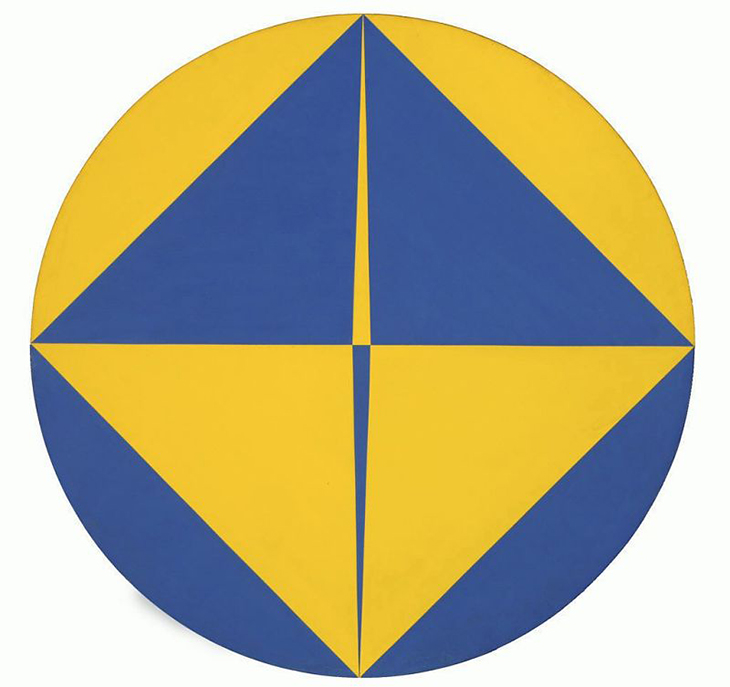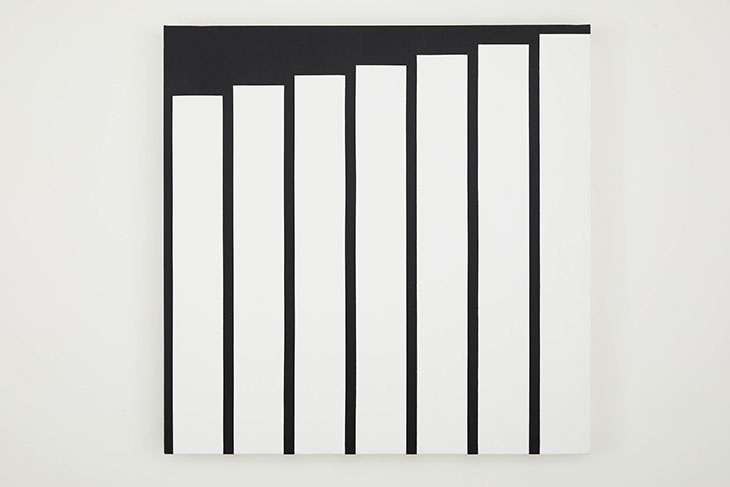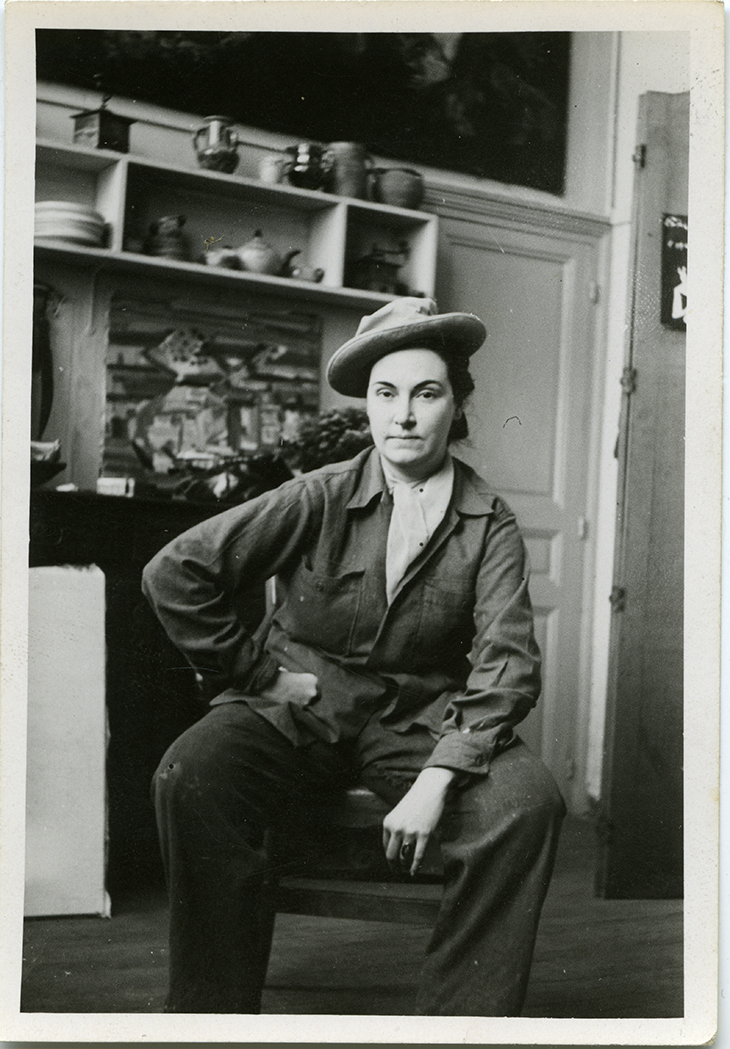All young deaths – Mozart, Christ, Egon Schiele – beg the same question: what would have happened had the dead lived longer? Deaths at a great age raise the opposite question. Do artists who lead unusually long lives risk becoming artefacts, museum pieces whose work is inevitably seen in terms of their age; interesting because fossilised?
It was a question often asked of Carmen Herrera, who has died at the age of 106. If Herrera found success only in her 90th year, she had by then been making art for eight decades. The child of Havana intellectuals, she began taking drawing lessons in 1923 at the age of eight. These continued at the convent school in Paris where she was sent in 1929, the year Dalí painted Le Grand Masturbateur and Magritte The Treachery of Images.
Although Herrera moved to New York in 1939 with her husband the American scholar Jesse Loewenthal and studied at the Art Students League – Louise Bourgeois, four years older, was a contemporary there – it was in Paris that she found the voice that would be hers for the next 75 years. This was something of a faux pas, historically speaking. Herrera sailed for France in the same year that Jackson Pollock made his first drip paintings, signalling a shift in the polarity of modern art across the Atlantic in precisely the opposite direction.

Rondo (Blue and Yellow) (1965), Carmen Herrera. Hirshhorn Museum and Sculpture Garden
Not only was Herrera in the wrong place, the influences she found in Paris were of the wrong time. Foremost among the artists she would discover while showing at the Salon des Réalités Nouvelles were the spectral masters of De Stijl and the Bauhaus. If the colours in her paintings were to be marked by a vibrancy airily dismissed by critics as ‘Cuban’, Herrera’s forms were the rigorous ones of Albers and Van Doesburg. This she ascribed to her training, in the Havana of the late 1930s, as an architect. In works such as Rondo (Blue and Yellow) (1965), form, space and colour were functions of each other. Herrera’s shapes – rhomboids, trapezoids, flattened triangles – were an exercise in efficiency, the playing-off of parts in a search for equilibrium between them.
This was not understood when she returned to New York in 1954. It would be five years before the psychiatrist and critic, Jules Langsner, coined the term ‘hard-edge abstraction’ to describe a kind of geometric painting then coming into fashion in California. It was a mode in which Herrera had been working, unsung, for a decade. Her gender did not help her case. As dogmatised by Clement Greenberg, abstract painters of the New York School were required to be male. Irving Sandler’s first history of the movement, published in 1970, included not a single woman artist. By the time hard-edge painting finally made it to Manhattan in the Sixties, it would be the province not of Carmen Herrera but of men such as Ellsworth Kelly and Kenneth Noland.

Verticals #2 (1989), Carmen Herrera. Photo: Andy Stagg. Courtesy Lisson Gallery; © Carmen Herrera
None of this seems to have troubled her unduly. In 1966, Hilton Kramer, venerable critic of the New York Times, grudgingly allowed that Herrera ‘brought something of her own,’ to ‘the impersonal conventions’ of geometric abstraction. It was rare, if faint, praise. Such shows as she could muster were low-key: shop windows and pavements were Herrera’s galleries. In 1984 she was finally given an institutional exhibition, although this was at the now defunct Alternative Museum in Greenwich Village, aimed at artists unshowable elsewhere. It was only in 2004, the year before she turned 90, that Herrera suddenly came to public attention.
A recommendation by a friend led to her taking part in a group show in TriBeCa with two other women abstractionists, one Brazilian and the other Colombian. The New York Times greeted this with astonishment. How could Herrera have gone unnoticed in the city for so long? Within days, an art foundation in Miami had bought five of her paintings, while an influential New York collector and the president of the Museum of Modern Art snapped up a dozen more between them. Within a decade, Herrera’s work was in major public collections around the world, from MoMA to Tate Modern.
After Loewenthal’s death in 2000, Herrera had gone on living in the loft they had moved into in 1967. Without her husband’s support, times had been hard. Now, a picture such as Blue Angle on Orange (1982–83) or Verticals #2 (1989) might sell for well into six figures. This new financial security allowed Herrera to have live-in care and to carry on working at home. True to form, at 105 she moved into sculpture, making lacquered aluminium pieces cantilevered from the wall. These were included in a show in London last year.
Teaching at Yale in old age, the Bauhaus-trained Josef Albers realised that students came to his lectures in the way they might visit dinosaurs in a museum, drawn by the fascination of an impossibly distant past. Carmen Herrera was more than two decades older than Albers when she died. Even in her successful last years, her art was seen in terms of its maker’s long life, its connection to modernism when it was still fresh and new. Her death releases it to be judged on its own terms, for the extraordinary work it is.

Carmen Herrera in her studio in Paris in c. 1948–53. Photo: courtesy Lisson Gallery; © Carmen Herrera

It’s time to judge Carmen Herrera’s extraordinary work purely on its own terms
Carmen Herrera in her studio in 2015. Photo: Jason Schmidt; courtesy Lisson Gallery; © Carmen Herrera
Share
All young deaths – Mozart, Christ, Egon Schiele – beg the same question: what would have happened had the dead lived longer? Deaths at a great age raise the opposite question. Do artists who lead unusually long lives risk becoming artefacts, museum pieces whose work is inevitably seen in terms of their age; interesting because fossilised?
It was a question often asked of Carmen Herrera, who has died at the age of 106. If Herrera found success only in her 90th year, she had by then been making art for eight decades. The child of Havana intellectuals, she began taking drawing lessons in 1923 at the age of eight. These continued at the convent school in Paris where she was sent in 1929, the year Dalí painted Le Grand Masturbateur and Magritte The Treachery of Images.
Although Herrera moved to New York in 1939 with her husband the American scholar Jesse Loewenthal and studied at the Art Students League – Louise Bourgeois, four years older, was a contemporary there – it was in Paris that she found the voice that would be hers for the next 75 years. This was something of a faux pas, historically speaking. Herrera sailed for France in the same year that Jackson Pollock made his first drip paintings, signalling a shift in the polarity of modern art across the Atlantic in precisely the opposite direction.
Rondo (Blue and Yellow) (1965), Carmen Herrera. Hirshhorn Museum and Sculpture Garden
Not only was Herrera in the wrong place, the influences she found in Paris were of the wrong time. Foremost among the artists she would discover while showing at the Salon des Réalités Nouvelles were the spectral masters of De Stijl and the Bauhaus. If the colours in her paintings were to be marked by a vibrancy airily dismissed by critics as ‘Cuban’, Herrera’s forms were the rigorous ones of Albers and Van Doesburg. This she ascribed to her training, in the Havana of the late 1930s, as an architect. In works such as Rondo (Blue and Yellow) (1965), form, space and colour were functions of each other. Herrera’s shapes – rhomboids, trapezoids, flattened triangles – were an exercise in efficiency, the playing-off of parts in a search for equilibrium between them.
This was not understood when she returned to New York in 1954. It would be five years before the psychiatrist and critic, Jules Langsner, coined the term ‘hard-edge abstraction’ to describe a kind of geometric painting then coming into fashion in California. It was a mode in which Herrera had been working, unsung, for a decade. Her gender did not help her case. As dogmatised by Clement Greenberg, abstract painters of the New York School were required to be male. Irving Sandler’s first history of the movement, published in 1970, included not a single woman artist. By the time hard-edge painting finally made it to Manhattan in the Sixties, it would be the province not of Carmen Herrera but of men such as Ellsworth Kelly and Kenneth Noland.
Verticals #2 (1989), Carmen Herrera. Photo: Andy Stagg. Courtesy Lisson Gallery; © Carmen Herrera
None of this seems to have troubled her unduly. In 1966, Hilton Kramer, venerable critic of the New York Times, grudgingly allowed that Herrera ‘brought something of her own,’ to ‘the impersonal conventions’ of geometric abstraction. It was rare, if faint, praise. Such shows as she could muster were low-key: shop windows and pavements were Herrera’s galleries. In 1984 she was finally given an institutional exhibition, although this was at the now defunct Alternative Museum in Greenwich Village, aimed at artists unshowable elsewhere. It was only in 2004, the year before she turned 90, that Herrera suddenly came to public attention.
A recommendation by a friend led to her taking part in a group show in TriBeCa with two other women abstractionists, one Brazilian and the other Colombian. The New York Times greeted this with astonishment. How could Herrera have gone unnoticed in the city for so long? Within days, an art foundation in Miami had bought five of her paintings, while an influential New York collector and the president of the Museum of Modern Art snapped up a dozen more between them. Within a decade, Herrera’s work was in major public collections around the world, from MoMA to Tate Modern.
After Loewenthal’s death in 2000, Herrera had gone on living in the loft they had moved into in 1967. Without her husband’s support, times had been hard. Now, a picture such as Blue Angle on Orange (1982–83) or Verticals #2 (1989) might sell for well into six figures. This new financial security allowed Herrera to have live-in care and to carry on working at home. True to form, at 105 she moved into sculpture, making lacquered aluminium pieces cantilevered from the wall. These were included in a show in London last year.
Teaching at Yale in old age, the Bauhaus-trained Josef Albers realised that students came to his lectures in the way they might visit dinosaurs in a museum, drawn by the fascination of an impossibly distant past. Carmen Herrera was more than two decades older than Albers when she died. Even in her successful last years, her art was seen in terms of its maker’s long life, its connection to modernism when it was still fresh and new. Her death releases it to be judged on its own terms, for the extraordinary work it is.
Carmen Herrera in her studio in Paris in c. 1948–53. Photo: courtesy Lisson Gallery; © Carmen Herrera
Unlimited access from just $16 every 3 months
Subscribe to get unlimited and exclusive access to the top art stories, interviews and exhibition reviews.
Share
Recommended for you
Review: ‘Radical Geometry’, South American art at the Royal Academy, London
The diversity of South American abstraction is one of its main strengths
Recognition at last for the women of Abstract Expressionism
‘They told me I would be more successful if I was a man, French, or dead.’
‘Her canvases breed uncertainty from certainty’ – the art of Carmen Herrera
Still working at the age of 105, the Cuban-born artist has had an unusually long career – and the results repay close attention